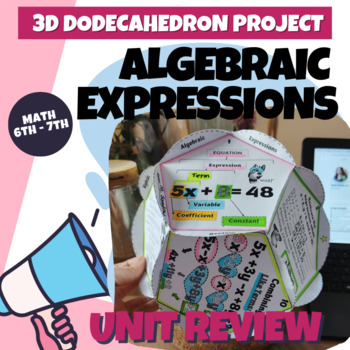Algebraic Expressions Unit Review 3D Dodecahedron Project
- PDF
- Easel Activity
What educators are saying
Description
Are you looking for a fun and engaging activity to review ALGEBRAIC EXPRESSIONS? Your students will love this dodecahedron project! Is perfect to end your unit as a formative assessment! Common core aligned, suitable for grades 6th, 7th, and homeschooling.
You can hang and display them around the room as classroom decor!
Review fractions on a number line with this FUN dodecahedron project!
This product includes:
6 pages (2 circles per page), Answer key, and student worksheet.
What is the content of each page?
•Page 1. Visual Diagram to understand the parts of an expression.
•Page 2. Practice evaluating expressions.
•Page 3. A visual diagram to translate words to math.
•Page 4. Writing algebraic expressions.
•Page 5. Math properties: Commutative and Associative Properties of Addition and Multiplication.
•Page 6. Math properties: Addition Property of Zero and Multiplication Property of Zero and One.
•Page 7. Describing steps to solve an expression using Math Properties
•Page 8. Identifying Properties.
•Page 9. The Distributive Property Diagram
•Page 10. Visual diagram for Combining Like Terms.
•Page 11. Simplifying expressions.
•Page 12. Factoring expressions using GCF.
FOLLOW ME! - Freebies every month!
Be the first to know about my store's freebies, promotions, and new products. Keep your wish list ready for discounts!
I appreciate your feedback! Also, TPT gives you credits that you can use on future purchases. --> Click here
This purchase is for one teacher only. This resource should not be shared with colleagues or used by an entire grade level, school, or district without purchasing the proper number of licenses. This resource may not be uploaded to the internet in any form, including classroom/personal websites or network drives. If you use other websites or resources (like YouTube, Google Apps, DESMOS, Quizzizz, Kahoot, GoFormative, TeacherMade, etc.) using any part of my material, please be sure it is set to private and only accessible by your students. These resources are for your students and can not go outside of that.
Do you want a personalized resource? Questions? Comments? please, email me at everythingforareason.store@gmail.com





